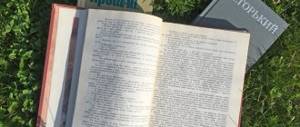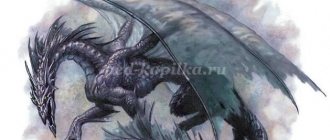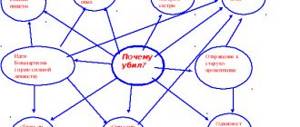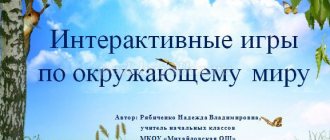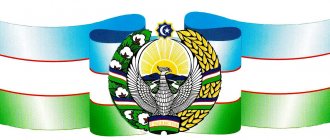Quiz lesson in 7th grade
Purpose of the game.
Develop interest in the subject; repeat the factual material received by students in literature lessons in the 7th grade.
At the core
lesson contains a television version of the quiz “Own Game”, adapted to school conditions:
- in each of the three rounds, participants are offered four topics containing three questions each - a total of 36 questions plus the final question;
- Each question, depending on the level of difficulty, is scored one, two or three points;
- teams of three or four people act as players;
- instead of an electronic display, a homemade display attached to a chalkboard is used: halves of A4 landscape sheets are glued together on the back side using tape (four rows of three sheets each), on the front side the numbers 1, 2, 3 are written with a marker, indicating the number question, and the number of points - this part of the scoreboard does not change throughout the game; on the left side of the digital scoreboard there is a strip of sheets of full A4 format, also glued together with tape, on their front side the names of the topics of the round are written - this part of the scoreboard changes every round; when during the game the team chooses a question, the student assistant closes the corresponding number on the scoreboard using half an A4 landscape sheet and an ordinary stationery pin;
- the score of the game on the board is kept by the second student-assistant; There are two possible rating options here: a tougher one - in accordance with the TV version of the game, that is, for each correct answer the team receives points, for each incorrect answer - it loses; softer - only correct answers are taken into account, and teams do not lose points for incorrect answers.
The material for the game is taken from the textbook: Literature: 7th grade. Reader for educational institutions / Author-comp. V.Ya. Korovina.
Topics and questions for the game
Interior
1. “The hut consisted of one room, smoky, low and empty, without floors or partitions. A tattered sheepskin coat hung on the wall. There was a single-barreled gun lying on the bench, a pile of rags was lying in the corner, a torch was burning on the table, flaring sadly and going out.”
Name the author from whose work the description of the interior is taken. (Ivan Sergeevich Turgenev.)
2. “The bright room was decorated in the taste of that time... Everything was cleanly smeared with colored clay. On the walls are sabers, whips, bird nets, nets and guns, a cleverly crafted horn for gunpowder, a golden bridle for a horse and fetters with silver plaques. The windows in the little room were small, with round, dull glass... There were red bends around the windows and doors. On the shelves in the corners were jugs, bottles and flasks of green and blue glass, carved silver goblets, gilded glasses...”
Name the owner of the described room. (Taras Bulba.)
3.
And he comes to his tall house, The oak table is not covered with a white tablecloth, And the candle in front of the image barely glows.
Name the hero who saw this interior. (Stepan Paramonovich Kalashnikov.)
Author
1. Each of these authors has autobiographical trilogies, the first books of which have the same title - “Childhood”. Name the authors of these books. (L.N. Tolstoy and A.M. Gorky.)
2. Name the poet who dedicated his poem to the wives of the Decembrists who followed their husbands to hard labor in Siberia. (N.A. Nekrasov.)
3. Name a prose writer who also wrote prose poems. (I.S. Turgenev.)
Name
1. The title of this story reflects the thought of A.P. Chekhov that some people in some situations are capable of behaving like this reptile. (Chekhov A.P. “Chameleon.”)
2. This story by Gogol is named after its main character. (“Taras Bulba.”)
3. Ivan Alekseevich Bunin used the name of these peasant shoes for the title of his story. (“Lapti.”)
Trails
1. The title of one of the stories by Evgeny Ivanovich Nosov is a metaphor: the author compares the short flowering period of poppies with this. (“Living flame.”)
2. This is the name of the form of poetic speech based on the comparison of two objects in order to explain one with the help of the other, for example:
So the king frowned his black eyebrows and focused his keen eyes on him, like a hawk looking from the heights of heaven at a young blue-winged dove.
(Comparison.)
3. What artistic medium does Alexander Tvardovsky use in the following lines:
They played through the smoky ravines The hasty waters of spring. And she walked at a slow pace Into the area between the Pakhra and Desna rivers.
(Personification.)
Poetry
1. What is the main difference between poetic speech and prosaic speech? (Rhythm, rhythmicity.)
2. This is the name in poetic speech for a group of verses related in meaning, as well as in the arrangement of rhymes. In writing, such groups are separated from one another by increased spacing. (Stanza.)
3. This is what a three-syllable poetic meter with stress on the third syllable is called, for example:
I was brought up by harsh nature, It is enough for me to notice at the feet of a dandelion a fluffy ball, and a hard blade of a plantain.
(Anapaest.)
Color
1. The beginning of the third part of Lermontov’s “Song about the Merchant Kalashnikov” foreshadows the tragic outcome of events. Even the color of the dawn rising over Moscow speaks about this. What color was the dawn? (“Over Moscow... the scarlet
dawn rises.”)
2. Describing the portrait of one of the Cossacks in the story “Taras Bulba,” Gogol says that his trousers were exactly as wide as this sea. (Black Sea.)
3. It was this color of bast shoes that the sick boy from I.A.’s story imagined in his delirium. Bunina. (Red bast shoes.)
Names
1. This hero’s name was Efim Dmitrievich, but in the village they called him differently. How? (Yushka.)
2. Maxim Gorky is a pseudonym. State the writer's real name. (Alexey Maksimovich Peshkov.)
3. Taking monasticism, the prince was named David, and the princess, his wife, Euphrosyne. But the title of the work uses their secular names. What were the names of the prince and princess before they became monks? (Peter and Fevronia of Murom.)
Folklore
1. Visual range.
Name the author of the picture, the most famous illustrator of Russian folk tales.
( Vasnetsov;
reproduction at the teacher’s choice.)
2. What is the main difference between a proverb and a saying? (Proverbs contain a complete thought, and sayings are simply apt expressions.)
3. In the epic “Volga and Mikula” there are the following lines:
We drove into an open field in an open field, We heard an oratay yelling in an open field, How an oratay yells in a field and whistles...
Who is Oratai and what is he doing in the open field? (The plowman plows the field.)
Flora
1. Remember the author and the title of the work, in which one of the characters picked ten ripe, sweet apples for the others, and took one sour one for himself. (Saltykov-Shchedrin M.E. “The Tale of How a Man Fed Two Generals.”)
2. Name a story in which a certain plant was endowed with human qualities: it missed its mother, did not want to be discouraged. (Platonov A.P. “Unknown Flower.”)
3. Name a work in which the hero sees the following picture: “Right from the school fence, a river meadow began, still green like summer, with white splashes of yarrow, goose feathers and some meadow mushrooms.” (Nosov E. “Doll.”)
Portrait
1. “He was short and thin; on his wrinkled face, instead of a mustache and beard, sparse gray hairs grew separately; his eyes were white, like a blind man’s, and there was always moisture in them, like never-cooling tears.” Who is he? (Yushka.)
2. “He was tall, broad-shouldered and beautifully built. His powerful muscles bulged out from under his wet, heavy shirt. A black curly beard covered half of his stern and courageous face. Small brown eyes looked boldly from under fused wide eyebrows.” Whose portrait is presented? (Biryuk.)
3.
Her rosy cheeks glow, Like the dawn in God’s sky; Her blonde, golden braids, braided in bright ribbons, run over her shoulders, wriggle, and kiss her white breasts.
Who are we talking about? (Alena Dmitrievna Kalashnikova.)
Scenery
1. In what work does the following landscape appear: “The sun has finally risen; the horse neighed subtly, and somehow unusually quickly everything around lightened up and turned pink; The gray dew on the fir trees and bushes became even more clearly visible, and the fog began to move, thinned out and began to reluctantly open the haystacks.” (Kazakov Yu. “Quiet morning.”)
2. Name the author and the work in which nature is described in this way: “A thunderstorm was approaching. Ahead, a huge purple cloud slowly rose from behind the forest; Long gray clouds were rushing above me and towards me; the willows moved and babbled anxiously. The stuffy heat suddenly gave way to cold; the shadows grew thicker.” (Turgenev I.S. “Biryuk.”)
3. From which work is this landscape taken: “The channel narrowed, became grassy, the clean sands at the bends were covered with cocklebur and tough butterbur, many unknown shoals and spits appeared”? (Nosov E. “Doll.”)
Plan of notes on literature grade 7 Lesson 1. Introductory
Literary theory: genre Equipment: exhibition of various publications of authors that will be studied in seventh grade. Epigraphs on the board:
I owe everything good about myself to books. M. Gorky Choose writers as you choose a friend. English proverb.
Progress of the lesson I. Introductory speech by the teacher. So, the new academic year begins and we begin to discover and study new names and works of the treasury of world literature. This year we will begin with the study of oral folk art, which you have already become acquainted with in grades 5 and 6. Then we will both study the works of Russian and Soviet writers, and the works of foreign authors. — What books did you read over the summer? — What works did you study last school year? The children share memories of books they read in the summer from the list of literature given by the teacher, and about works of literature studied last year.
II. Introduction to the textbook. Working conditions are in the classroom. 1. Working with terms. Guys, in seventh grade we will get acquainted with many interesting works written by authors familiar to you and those you do not yet know. Our cross-cutting task in the process of studying these works will be the task of learning not only to read thoughtfully, but also to study the work. The world of books and literature is a special world that has its own laws, and the science that studies these laws is called literary criticism. We will begin to master these laws in the seventh grade in order to better understand in the future every book that we happen to read. To do this, we will need a textbook, a notebook, a notebook for creative work and a dictionary, where we will write down the main literary terms. (We will also use the literature manual by V. Ya. Korovina “Reading, Thinking, Arguing...”) A dictionary for recording terms could have been kept in past years. If it is preserved, you can continue it. It is very important to explain to schoolchildren that, despite the fact that the terms are at the end of the textbook, it is necessary to write down all important definitions in order to better remember them and save them for subsequent years of study. So, the first word that we will write in our dictionary will be the word “Literary criticism”. Read the meaning of this term on page 408 (Part II p. 236 - new edition in 2 parts, hereinafter NI) of the textbook. (One of the students reads aloud.) - What are “specificity” and “essence”, how do you understand these words?
Card 1 Specificity - a set (set, complex) of specific (special, distinctive, characteristic only of a given object) features. (Ozhegov S.I., Shvedova N.Yu. Explanatory dictionary of the Russian language. M.: 2001.)
Card 2 Essence is the same as “essence”: the most important and essential thing in something. (S. I. Ozhegov and N. Yu. Shvedova. Explanatory dictionary of the Russian language. M., 2001.)
It is quite possible that one of the students will give a fairly qualified answer to this question. If not, you can either have them read the meanings of those words in a dictionary or give them the corresponding meanings from the dictionary on the cards. — Guys, what do you think is the most important thing in literature? What, for example, distinguishes it from other forms of art: music, painting? (The main material is the word. Thought is conveyed through images) - What special features distinguish literature? What, for example, is there in fiction that is not in journalism and scientific literature? (Plot in a story, novel, rhyme in a poem, metaphors, comparisons, personifications) In the seventh grade, you and I will begin to master a huge set of tools with the help of which literary scholars study the laws by which a work of art lives. Let's start with a concept that we will write down in our dictionary: “genre”. Read the definition of this concept on page 407 (II - 235-NI). — In what genre were the following works written: “Borodino” by M. Yu. Lermontov, “The Prisoner” by A. S. Pushkin, “The Night Before Christmas” by N. V. Gogol, “The Horse's Name” by A. P. Chekhov, etc.? - Give examples of stories, tales, fairy tales, poems, fables, novels, comedies, tragedies that you have read yourself. You see that a poem differs significantly from a novel, a story from a fable. How to understand this variety of genres? At the end of the textbook, on page 412 (II -241, NI), after the dictionary of literary terms, we will find the section “Reference materials on the theory of literature.” A small table, as we see, divides the entire variety of genres into three main types. What types of genres are divided into? — How can we define the main features of epic, lyricism, and drama? Let's write these definitions in the dictionary. Epic (epic genres) is a type of literature that combines works that tell about events external to the author, most often there is a plot. Lyrics are a type of literature in which the author expresses his immediate feelings; usually a lyric work has a poetic form. Drama is a type of literature in which some conflict or contradiction is depicted: Typically, dramatic works are created for performance on stage. The table from the textbook is also recorded and remembered.
2. Introduction to the textbook. — Guys, look at the table of contents of the textbook. What parts is the textbook divided into? The names of these parts are in italics. Please note that in almost every paragraph dedicated to an individual author, there are chapters that contain information about the writers' creative laboratory. For example, “In Pushkin’s creative laboratory” or “How Lermontov worked” (students open the beginning of these chapters on the appropriate pages). This is a very important part of the science of literature - the study of the biography and creative method of the writer. This will also be a very important part of our work with you. — We have already become acquainted with the vocabulary and theoretical sections. On which page will we find a dictionary of names? In the text of the textbook they are marked with asterisks. You know that not all writers who existed in the past and exist now fall into our field of vision. We will find brief information about writers and literary critics, artists, critics in the dictionary of names. After the content, at the end of the textbook, read which works you will have to read if you borrow them from the library, since they are not in the textbook. Now open the very first paragraph of the textbook. Books, as you know, can be difficult or easy to read; it happens that the same book may seem boring, and then interesting. — Why do you think you shouldn’t rush when reading a book, even the most exciting one? — Read excerpts from articles by Gorky, Paustovsky and Likhachev. Find information about authors in the dictionary of names. Is there a need to look for information about Gorky? Why? - Look at the table of contents of the textbook and answer why there is no information about D. S. Likhachev in the dictionary of names?
Homework. 1. Complete task No. 2 of the textbook in writing. 2. Read the article “Epics”.
